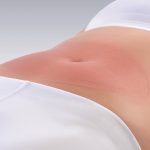
Τα ξανθελάσματα εμφανίζονται ως κίτρινες κηλίδες ή πλάκες και συνήθως εντοπίζονται στο δέρμα των βλεφάρων. Αποτελούνται από χοληστερόλη και σε ποσοστό περίπου 50% των ασθενών είναι ένδειξη ότι η χοληστερόλη στο αίμα είναι υψηλή. Για το λόγο οι ασθενείς με ξανθέλασμα πρέπει να ελέγχουν τα λιπίδια αίματος. Τα ξανθελάσματα δεν εξαφανίζονται από μόνα τους, αλλά αντιθέτως μπορεί να μεγαλώσουν με την πάροδο του χρόνου ή και να πολλαπλασιαστούν.
Συνηθέστερα απαντώνται στη μέση ηλικία και συχνότερα στις γυναίκες, καθώς και σε άτομα μεσογειακής και ασιατικής καταγωγής. Αυτές οι αθροίσεις χοληστερόλης κάτω από την επιδερμίδα αφαιρούνται για αισθητικούς λόγους .
Τα ξανθελάσματα μπορούν να αντιμετωπιστούν με διάφορους τρόπους. Με όλες τις θεραπείες υπάρχει πιθανότητα να επανεμφανιστούν αν το άτομο έχει την τάση, συνήθως σε λίγα χρόνια.
Η πιο αποτελεσματική θεραπεία τους επιτυγχάνεται με CO2 laser, το οποίο καταστρέφει τα ξανθελάσματα προκαλώντας εξάχνωση της επιδερμίδας με αποτέλεσμα την εξάλειψη της βλάβης . Μετά τη θεραπεία υπάρχει κρούστα στην περιοχή του ξανθελάσματος η οποία υποχωρεί μετά από μια εβδομάδα αφήνοντας νέα επιδερμίδα στη θέση του. Το πλεονέκτημα της θεραπείας με Laser CO2 είναι η διατήρηση όλης της έκτασης της επιφάνειας του δέρματος, αφού το δέρμα αναγεννιέται από τη βασική του στιβάδα και δεν αφαιρείται. Έτσι, αν τα ξανθελάσματα υποτροπιάσουν μπορεί να επαναληφθεί.
Peeling τριχλωροοξεικού οξέος (TCA), μιας χημικής ουσίας που προκαλεί απολέπιση στιβάδων του δέρματος και μαζί καταστροφή του ξανθελάσματος .
Διαθερμοπηξία κατά την οποία καυτηριάζεται το ξανθέλασμα με τη χρήση ηλεκτρικού ρεύματος που μεταφέρεται με ηλεκτρόδιο στην επιδερμίδα . Πρόκειται για τεχνική που έχει σε μεγάλο βαθμό αντικατασταθεί από το Laser CO2.
Τέλος, η χειρουργική αφαίρεση αποτελεί παραδοσιακή μέθοδος αντιμετώπισης των ξανθελασμάτων. Η βλάβη αφαιρείται και το δέρμα συρράπτεται. Με όλες τις θεραπείες τα ξανθελάσματα μπορεί να υποτροπιάσουν, και η μέθοδος αυτή έχει περιορισμούς στο πόσες φορές μπορεί να επαναληφθεί, αφού με κάθε επέμβαση αφαιρείται και δέρμα.
Η θεραπεία των ξανθελασμάτων γίνεται με τοπική αναισθησία η οποία εφαρμόζεται είτε με τη μορφή κρέμας είτε σε ενέσιμη μορφή . Είναι πολύ καλά ανεκτή και αφήνει άριστο αισθητικό αποτέλεσμα όταν επιτελείται από ειδικό δερματολόγο. Ο χρόνος αποκατάστασης είναι περίπου 7-10 ημέρες, χρονικό διάστημα κατά το οποίο απαιτείται τοπική φροντίδα της περιοχής με αντιβιοτική κρέμα. Η αντιηλιακή προστασία είναι αναγκαία μέχρι το δέρμα να επανέλθει πλήρως στη φυσιολογική του κατάσταση.






No comment yet, add your voice below!